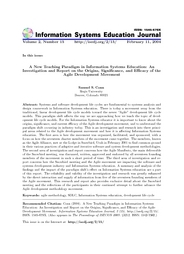Volume 2
Volume 2, Number 15 |
February 11, 2004 |
Abstract: Systems and software development life cycles are fundamental to systems analysis and design coursework in Information Systems education. There is today a movement away from the traditional, linear development life cycle models toward the newer “Agile” development life cycle models. This paradigm shift affects the way we are approaching how we teach the topic of development life cycle models. For the Information Systems educator it is important to know about the origins, significance, and current efficacy of the Agile development movement, and to understand the paradigm shift occurring in industry today. This is an investigation and research into three principal areas related to the Agile development movement and how it is affecting Information Systems education. The first area is how the movement was organized, facilitated, and sponsored, with a focus on how the seventeen charter members of the movement came together. The members, known as the Agile Alliance, met at the Lodge in Snowbird, Utah in February 2001 to find common ground in their various practices of adaptive and iterative software and system development methodologies. The second area of investigation and report concerns how the Agile Manifesto, the main deliverable of the Snowbird meeting, was discussed, written, approved and endorsed by all seventeen founding members of the movement in such a short period of time. The third area of investigation and report concerns how the Snowbird meeting and the Agile movement are impacting the software and systems development industry and Information Systems education. A summary and analysis of the findings and the impact of the paradigm shift’s effect on Information Systems education are a part of this report. The reliability and validity of the investigation and research was greatly enhanced by the direct interaction and supply of information from five of the seventeen founding members of the Agile movement. This research and report also provides exclusive detail about the Snowbird meeting and the reflections of the participants in their continued attempt to further advance the Agile development methodology movement.
Keywords: agile methodology, SDLC, Information Systems education, development life cycle
Download this issue: ISEDJ.2(15).Conn.pdf (Adobe PDF, 19 pages, 1424 K bytes)
Preview the contents: Conn.txt (ASCII txt, 64 K bytes)
Recommended Citation: Conn (2004). A New Teaching Paradigm in Information Systems Education: An Investigation and Report on the Origins, Significance, and Efficacy of the Agile Development Movement. Information Systems Education Journal, 2 (15). http://isedj.org/2/15/. ISSN: 1545-679X. (A preliminary version appears in The Proceedings of ISECON 2003: §3212. ISSN: 1542-7382.)
